-
 Bitcoin
Bitcoin $117900
0.31% -
 Ethereum
Ethereum $3766
0.28% -
 XRP
XRP $3.176
-0.31% -
 Tether USDt
Tether USDt $1.000
0.00% -
 BNB
BNB $795.6
1.51% -
 Solana
Solana $186.8
-1.09% -
 USDC
USDC $0.9999
-0.01% -
 Dogecoin
Dogecoin $0.2353
-1.33% -
 TRON
TRON $0.3226
1.49% -
 Cardano
Cardano $0.8172
-1.08% -
 Sui
Sui $4.178
3.06% -
 Hyperliquid
Hyperliquid $43.05
-3.39% -
 Stellar
Stellar $0.4367
-0.57% -
 Chainlink
Chainlink $18.62
1.47% -
 Hedera
Hedera $0.2828
6.63% -
 Bitcoin Cash
Bitcoin Cash $584.7
5.65% -
 Avalanche
Avalanche $24.81
2.53% -
 Litecoin
Litecoin $112.8
-0.88% -
 UNUS SED LEO
UNUS SED LEO $8.975
-0.08% -
 Shiba Inu
Shiba Inu $0.00001395
-1.07% -
 Toncoin
Toncoin $3.285
-1.05% -
 Ethena USDe
Ethena USDe $1.001
0.01% -
 Polkadot
Polkadot $4.123
0.76% -
 Uniswap
Uniswap $10.49
-0.18% -
 Monero
Monero $326.5
0.14% -
 Dai
Dai $0.9999
-0.02% -
 Bitget Token
Bitget Token $4.576
0.34% -
 Pepe
Pepe $0.00001247
-1.55% -
 Cronos
Cronos $0.1400
3.77% -
 Aave
Aave $295.1
-0.73%
How to use the double moving average crossover to identify the resonant buying and selling points of trends in different cycles?
The double moving average crossover strategy uses short-term and long-term averages to signal buying and selling points, enhancing traders' market trend alignment.
Jun 09, 2025 at 01:50 pm
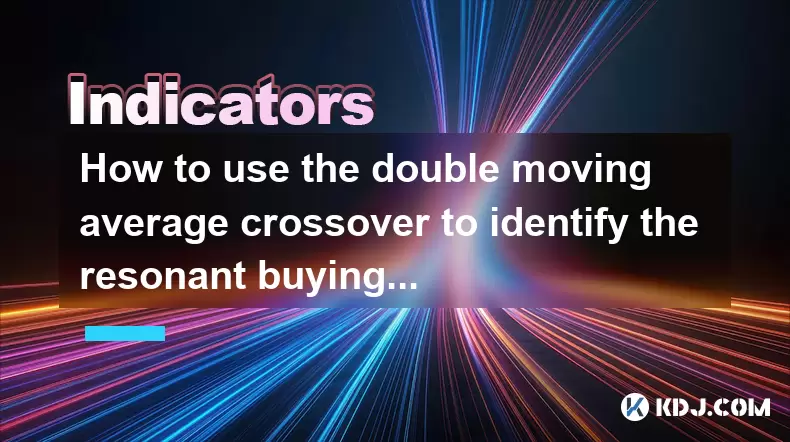
The double moving average crossover strategy is a popular technical analysis tool used by cryptocurrency traders to identify potential buying and selling points within different market cycles. This method leverages the power of two moving averages, typically a short-term and a long-term moving average, to signal trend changes and potential entry and exit points. By understanding how to effectively apply this strategy, traders can enhance their ability to resonate with market trends and make informed trading decisions.
Understanding Moving Averages
Moving averages are fundamental tools in technical analysis that smooth out price data to create a single flowing line, making it easier to identify the direction of the trend. There are several types of moving averages, but the most commonly used in the double moving average crossover strategy are the Simple Moving Average (SMA) and the Exponential Moving Average (EMA). The SMA calculates the average price over a specific number of periods, while the EMA gives more weight to recent prices, making it more responsive to new information.
Setting Up the Double Moving Average Crossover
To set up a double moving average crossover strategy, traders need to choose two different moving averages. Typically, a short-term moving average (e.g., 10-day or 20-day) and a long-term moving average (e.g., 50-day or 200-day) are used. The choice of periods depends on the trader's preferred time frame and trading style.
- Select the short-term moving average: This could be a 10-day SMA or a 20-day EMA.
- Select the long-term moving average: This could be a 50-day SMA or a 200-day EMA.
- Apply these moving averages to your chosen cryptocurrency chart: Most trading platforms allow you to easily add these indicators to your chart.
Identifying Buying and Selling Signals
The core of the double moving average crossover strategy lies in the interaction between the short-term and long-term moving averages. A buy signal is generated when the short-term moving average crosses above the long-term moving average, indicating a potential upward trend. Conversely, a sell signal is generated when the short-term moving average crosses below the long-term moving average, suggesting a potential downward trend.
- Buy signal: When the 10-day SMA crosses above the 50-day SMA, it may be a good time to enter a long position.
- Sell signal: When the 10-day SMA crosses below the 50-day SMA, it may be a good time to exit a long position or enter a short position.
Applying the Strategy to Different Market Cycles
The double moving average crossover strategy can be applied to different market cycles, including bull markets, bear markets, and sideways markets. Each cycle presents unique opportunities and challenges, and understanding how to adapt the strategy is crucial.
- Bull markets: In a bull market, the strategy can help identify optimal entry points for long positions. Traders should look for repeated buy signals as the market continues to rise.
- Bear markets: In a bear market, the strategy can help identify optimal entry points for short positions. Traders should look for repeated sell signals as the market continues to decline.
- Sideways markets: In a sideways market, the strategy can help traders avoid false signals by waiting for a clear breakout above or below the moving averages.
Fine-Tuning the Strategy
To enhance the effectiveness of the double moving average crossover strategy, traders can fine-tune their approach by adjusting the moving average periods and incorporating additional technical indicators.
- Adjusting moving average periods: Experiment with different combinations of short-term and long-term moving averages to find what works best for your trading style and the specific cryptocurrency you are trading.
- Incorporating additional indicators: Use indicators such as the Relative Strength Index (RSI) or the Moving Average Convergence Divergence (MACD) to confirm signals and reduce the likelihood of false positives.
Practical Example of Using the Strategy
Let's consider a practical example of using the double moving average crossover strategy to trade Bitcoin (BTC).
- Step 1: Open your trading platform and select a Bitcoin chart with a timeframe that suits your trading style (e.g., daily chart).
- Step 2: Add a 20-day EMA and a 50-day EMA to the chart.
- Step 3: Monitor the chart for crossovers. If the 20-day EMA crosses above the 50-day EMA, this is a potential buy signal.
- Step 4: Confirm the signal using additional indicators such as the RSI. If the RSI is not overbought (below 70), it may be a good time to enter a long position.
- Step 5: Set a stop-loss order below a recent low to manage risk.
- Step 6: If the 20-day EMA crosses below the 50-day EMA, this is a potential sell signal. Exit the long position or consider entering a short position.
Managing Risk and Position Sizing
Effective risk management is crucial when using the double moving average crossover strategy. Traders should always set stop-loss orders to limit potential losses and use appropriate position sizing to manage their overall exposure.
- Stop-loss orders: Place stop-loss orders below recent lows for long positions and above recent highs for short positions.
- Position sizing: Determine the size of your position based on your risk tolerance and the amount of capital you are willing to risk on each trade.
Backtesting the Strategy
Before applying the double moving average crossover strategy to live trading, it's essential to backtest it using historical data. This can help you understand the strategy's performance under different market conditions and refine your approach.
- Select a historical period: Choose a period that includes various market cycles (bull, bear, and sideways).
- Apply the strategy: Use trading software or a spreadsheet to simulate trades based on the double moving average crossover signals.
- Analyze the results: Calculate the strategy's win rate, average profit per trade, and maximum drawdown to assess its effectiveness.
Frequently Asked Questions
Q1: Can the double moving average crossover strategy be used for day trading?
Yes, the double moving average crossover strategy can be adapted for day trading by using shorter moving average periods, such as a 5-day and 10-day EMA on an hourly chart. However, day traders should be aware of increased volatility and adjust their risk management accordingly.
Q2: How does the choice of moving average type (SMA vs. EMA) affect the strategy's performance?
The choice between SMA and EMA can impact the strategy's responsiveness. The EMA, being more sensitive to recent price changes, may generate signals more quickly than the SMA, which could be beneficial in fast-moving markets but may also lead to more false signals.
Q3: Is it necessary to use additional indicators with the double moving average crossover strategy?
While not strictly necessary, using additional indicators such as the RSI or MACD can help confirm signals and reduce the risk of false positives. These indicators can provide a more comprehensive view of market conditions and enhance the reliability of the strategy.
Q4: How can I adapt the double moving average crossover strategy for different cryptocurrencies?
The strategy can be adapted for different cryptocurrencies by adjusting the moving average periods based on the specific volatility and trading volume of each cryptocurrency. For highly volatile assets, shorter moving average periods may be more effective, while for less volatile assets, longer periods may be more suitable.
Disclaimer:info@kdj.com
The information provided is not trading advice. kdj.com does not assume any responsibility for any investments made based on the information provided in this article. Cryptocurrencies are highly volatile and it is highly recommended that you invest with caution after thorough research!
If you believe that the content used on this website infringes your copyright, please contact us immediately (info@kdj.com) and we will delete it promptly.
- Cryptos to Watch in 2025: Punisher Coin, Chainlink, and the Altcoin Arena
- 2025-07-27 18:30:13
- Bitcoin, Altcoins, Rebound: Navigating the Crypto Comeback Trail
- 2025-07-27 18:30:13
- Ethereum, Bitcoin, and Altcoins: A Shift in Crypto Tides?
- 2025-07-27 19:10:13
- Windtree Therapeutics' Bold BNB Strategy: A $520 Million Crypto Play
- 2025-07-27 19:10:13
- Solana, Staking, and Unilabs: What's the Buzz in the Crypto Space?
- 2025-07-27 16:50:13
- VeChain, HBAR, Remittix: Navigating the Crypto Landscape in 2025
- 2025-07-27 17:10:12
Related knowledge
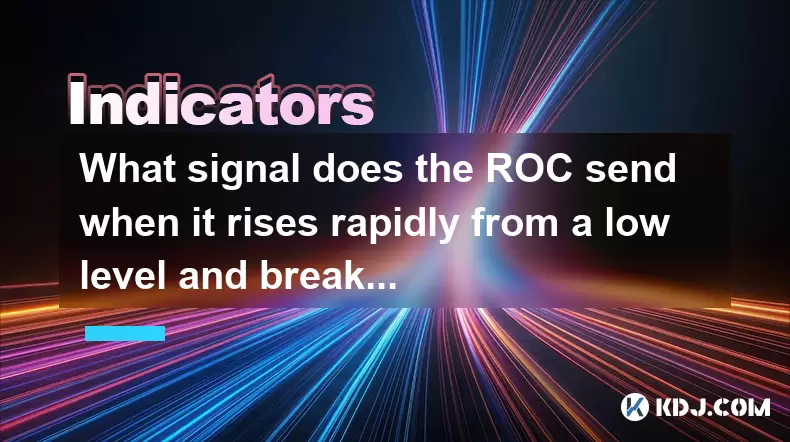
What signal does the ROC send when it rises rapidly from a low level and breaks through the zero axis?
Jul 27,2025 at 10:15am
Understanding the Rate of Change (ROC) IndicatorThe Rate of Change (ROC) is a momentum-based oscillator used in technical analysis to measure the perc...
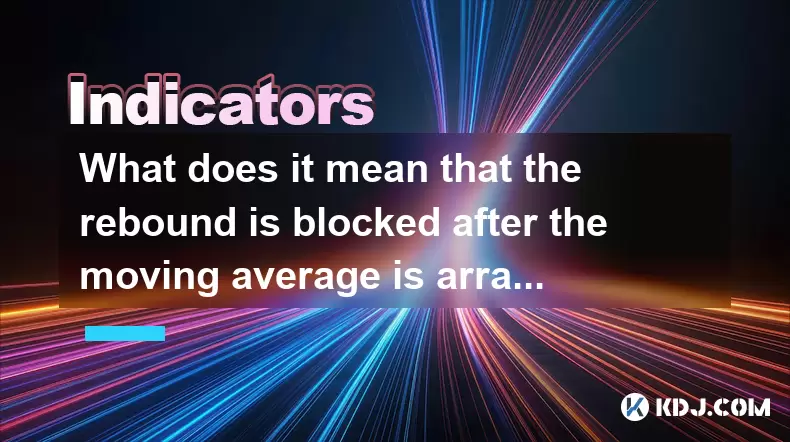
What does it mean that the rebound is blocked after the moving average is arranged in a short position for the first time?
Jul 26,2025 at 10:51am
Understanding the Short-Term Moving Average ConfigurationWhen traders refer to a 'short position arrangement' in moving averages, they are describing ...
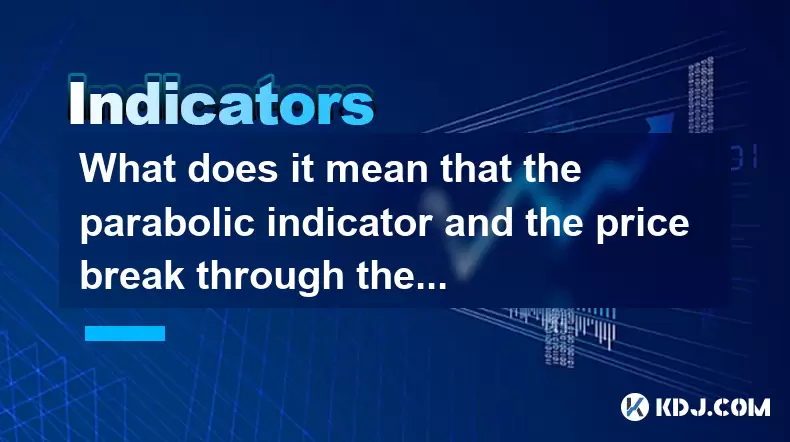
What does it mean that the parabolic indicator and the price break through the previous high at the same time?
Jul 26,2025 at 07:22pm
Understanding the Parabolic Indicator (SAR)The Parabolic SAR (Stop and Reverse) is a technical analysis tool developed by J. Welles Wilder to identify...
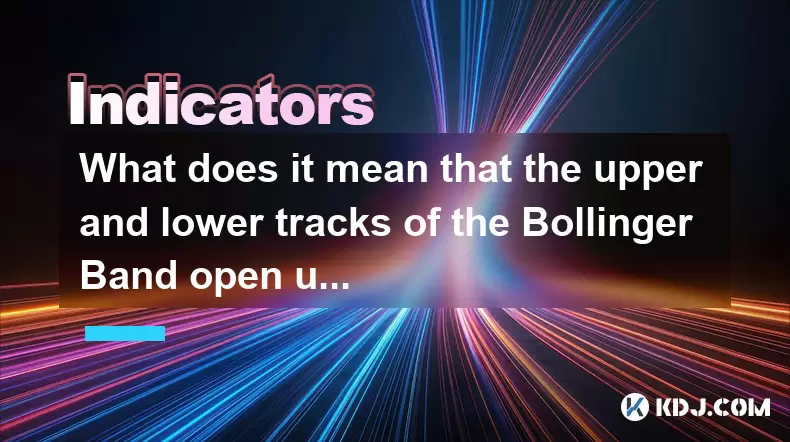
What does it mean that the upper and lower tracks of the Bollinger Band open upward at the same time?
Jul 27,2025 at 02:49pm
Understanding the Bollinger Band StructureThe Bollinger Band is a widely used technical analysis tool developed by John Bollinger. It consists of thre...
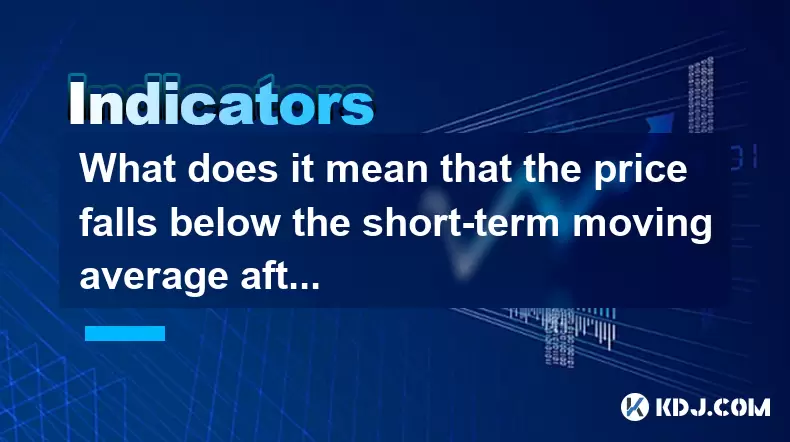
What does it mean that the price falls below the short-term moving average after the RSI top divergence?
Jul 26,2025 at 11:01pm
Understanding RSI Top Divergence in Cryptocurrency TradingThe Relative Strength Index (RSI) is a momentum oscillator widely used in cryptocurrency tra...
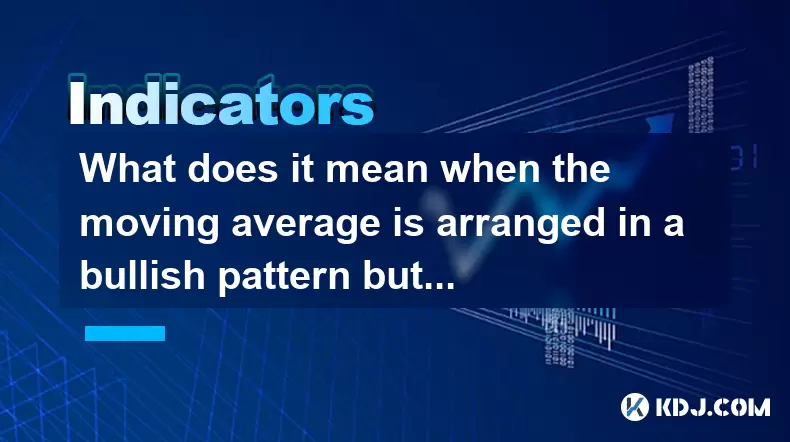
What does it mean when the moving average is arranged in a bullish pattern but the MACD bar is shortened?
Jul 27,2025 at 06:07am
Understanding the Bullish Moving Average PatternWhen traders observe a bullish moving average pattern, they typically refer to a configuration where s...

What signal does the ROC send when it rises rapidly from a low level and breaks through the zero axis?
Jul 27,2025 at 10:15am
Understanding the Rate of Change (ROC) IndicatorThe Rate of Change (ROC) is a momentum-based oscillator used in technical analysis to measure the perc...

What does it mean that the rebound is blocked after the moving average is arranged in a short position for the first time?
Jul 26,2025 at 10:51am
Understanding the Short-Term Moving Average ConfigurationWhen traders refer to a 'short position arrangement' in moving averages, they are describing ...

What does it mean that the parabolic indicator and the price break through the previous high at the same time?
Jul 26,2025 at 07:22pm
Understanding the Parabolic Indicator (SAR)The Parabolic SAR (Stop and Reverse) is a technical analysis tool developed by J. Welles Wilder to identify...

What does it mean that the upper and lower tracks of the Bollinger Band open upward at the same time?
Jul 27,2025 at 02:49pm
Understanding the Bollinger Band StructureThe Bollinger Band is a widely used technical analysis tool developed by John Bollinger. It consists of thre...

What does it mean that the price falls below the short-term moving average after the RSI top divergence?
Jul 26,2025 at 11:01pm
Understanding RSI Top Divergence in Cryptocurrency TradingThe Relative Strength Index (RSI) is a momentum oscillator widely used in cryptocurrency tra...

What does it mean when the moving average is arranged in a bullish pattern but the MACD bar is shortened?
Jul 27,2025 at 06:07am
Understanding the Bullish Moving Average PatternWhen traders observe a bullish moving average pattern, they typically refer to a configuration where s...
See all articles

























































































